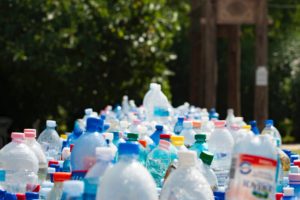Is it Time to Classify Plastics as Hazardous Wastes?

Plastics are chemically inert, that’s a common belief.
Yet in 2013, in the science journal Nature, a group of scientists started a call to classify plastics as hazardous wastes. Their argument? Plastics, like the typical hazardous waste we all know, also pose harm to human health and the environment, and that applying hazardous waste disposal practices would easily solve our global woes on plastic wastes.
The group then was led by ecologists Chelsea M. Rochman and Mark Anthony Browne. They stated that, as the physical dangers of plastic wastes are already known, only a few people know that there are also imminent chemical and medical dangers from supposedly chemically-inert plastic products. They urged major plastic-producing countries—like US, China, and European nations—to act on the reclassification of plastics.
What are plastics?
The ability to be shaped into almost any object with practical value is what makes plastics so popular. Chairs, drums, food containers, bulletproof vests, packaging materials, bags, vehicles—almost anything around us can be constructed from plastics. Being lightweight, low in cost, and reasonably durable, plastics have replaced metals and glass in many areas of application.
Despite these desirable properties, plastics are major contributors to pollution due to their nature to degrade very slowly. In fact, their degradation takes years, decades or even centuries, making them practically non-degradable materials.
As plastic wastes continue to litter our lands and bodies of water, they continue to disrupt the ecosystem and lives of organisms in these environments. That’s why countries have been pushing the principle of 3R—Reduce, Reuse and Recycle—to minimize the impact of plastics. Still, this has not deterred the increasing amount of plastic wastes we are generating every day. The Environmental Protection Agency or EPA noted that only around 12% of plastic materials gets recycled.
The researchers who made the call for reclassification focused their targets on four plastics believed to be the most harmful and hard to recycle: PVC (polyvinyl chloride); polystyrene, commonly known as Styrofoam; polyurethane; and polycarbonate. You can find these materials in wide applications, from pipes to bottles to bed mattresses.
The problem with plastics
For a waste to be deemed as a “hazardous waste,” it must pose dangers to human health or the environment. Due to these hazards, such wastes must be managed carefully and responsibly as improper disposal could lead to major health and environmental issues. In many countries, regulations are in place, and government agencies like EPA exist to ensure hazardous wastes are being handled properly.
Right now, plastics are classified as an ordinary solid waste, like food scraps and grass clippings. Under this classification, plastics are allowed to be disposed of in the garbage bin and ultimately into our landfills. Here are some arguments why plastics must be reclassified as hazardous wastes:
- Plastics are practically non-degradable. It could take up to 500 years to degrade certain types of plastics. As they remain intact for long periods of time, dumped plastics will continue to accumulate on the ground, which reduces the value and cultivability of lands. Plastic debris also tends to continue absorbing pollutants like toxic metals and residual pesticides.
- Plastics also clog sewage and pipelines. They block waterways or the seepage of water into the soil. Five trillion pieces of plastics (roughly 250,000 metric tons) find their way into the ocean, creating massive “plastic soups” as seen in the Atlantic and the Pacific (the latter known as the “Pacific Garbage Patch”). Apart from the ghastly sight of floating plastic debris, these wastes also cause harms to the aquatic environment and the living inhabitants there. As they float in water or settle into lands, plastics can be ingested by animals or other organisms, disrupting the food web balance.
- Direct burning as a way of disposing plastics is harmful as well. This method emit gases and fumes which may be harmful to human health. Not only that, burning plastics also emits carbon dioxide, a greenhouse gas that plays a role in global warming.
- Exposure to materials and processes involving plastics production pose harm to humans and other organisms. The process of manufacturing plastic products produce pollutants and other toxic by-products that can find their paths into waterways, ground or any part of the environment. Some raw materials used to make them are also known hazardous materials, like the monomers. For instance, workers are exposed to toxic vinyl chloride fumes (which is a known carcinogen) during PVC production.
- As a final product, plastics still deliver varying degrees of hazards. Certain additives (like Azo dyes) and residual ingredients (like residual monomers and Bisphenol A) are a threat to consumer health. These components tend to seep out during usage or leach into the ground when plastic wastes are dumped haphazardly.
The Benefits of Reclassification
Despite the aforementioned hazards, plastics continue to grow in popularity. If the current trend of our over-reliance to plastics continues, plastic production could exponentially grow to 33 billion tons in 2050.
Highlight the hazards and apply the rules of hazardous wastes on plastics
Apart from highlighting the toxic properties, the one benefit of reclassifying plastics into the hazardous category is to push changes on how plastics are made and how plastics are disposed of. Hazardous wastes are monitored well and handled more responsibly so changing the classification of plastics will make problematic areas be immediately cleaned by EPA and relevant government agencies.
There will be less waste in landfills
Production of plastics is still growing exponentially so once the hazardous waste classification is applied, regulations can now cover plastics so they won’t go to landfills or be forced to be recycled fully. As hazardous wastes, mandated agencies will have more tools and funding to monitor and clean up plastic wastes.
There will be less toxic materials in our oceans
There will be less worry about cleaning up those “plastic soups” floating out in our oceans. We also protect marine life and other living things from ingesting plastic debris.
Reclassification will push the industry to look for safer substitutes
Reclassification could spur more innovation and research into biodegradable and eco-friendly plastics. By using better plastics, we can still get the benefits of the awesome properties of plastics without worrying about polluting our environment or causing harm to ourselves.

Author Bio
Walter H. Singer is the CEO, President and Founder of ACTenviro, a bio hazardous waste disposal company. He has led the firm to be the leader in providing hazardous waste disposal services around California.
